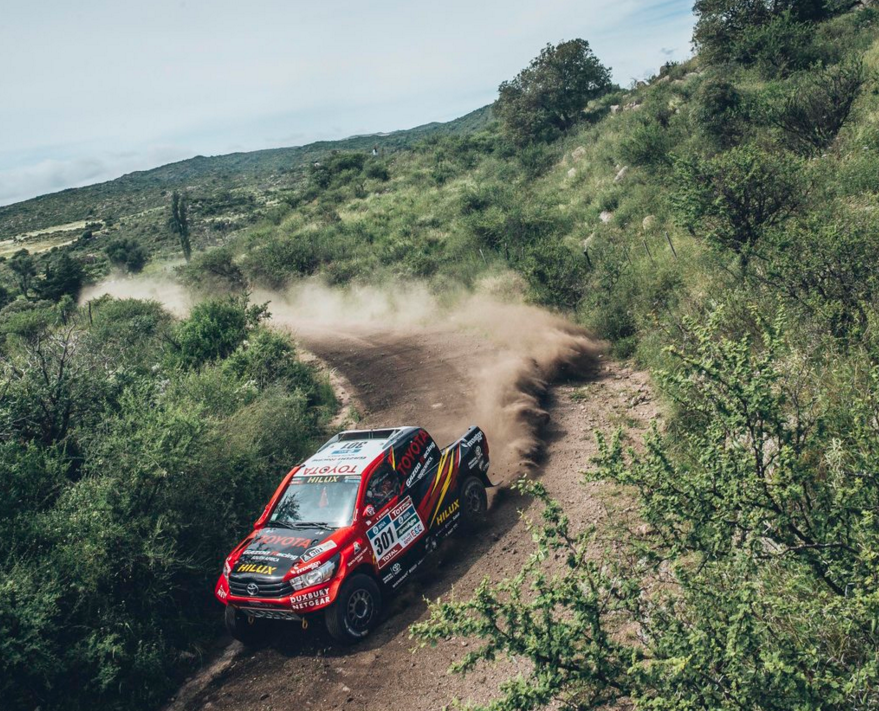The high altitudes of Stage 5 of Dakar 2016 placed the crews of Toyota Gazoo Racing SA under extreme pressure, not only because of the performance differences between the normally aspirated V8-powered Toyota Hilux’s engines, but also because of the strain the rapid rise to heights over 4,300 meters placed on their bodies. Even so, the team is in good spirits, even though they are already looking forward to returning to lower altitudes.
Especially Yazeed al Rajhi, paired with navigator Timo Gottschalk (#305) in one of the three Toyota Gazoo Racing SA Hilux race vehicles, fell foul to the effects of the high altitudes. He struggled with headaches and stomach cramps throughout the stage, but is upbeat about tackling Stage 6, even though it remains at the same extreme altitude as Stage 5.
“We will have to see how we go, but we will certainly fight hard to regain some of the time we lost today,” said Yazeed from the bivouac at the Bolivian town of Uyuni, near the famous salt flats.
Yazeed/Gottschalk managed only the 15th-fastest time on Stage 5, losing 16 minutes in the overall standings in the process. This places them in 10th overall now, though they will start Stage 6 in the position they finished Stage 5.
“Unfortunately this means that they will have a dust gap of only two minutes,” said Toyota Gazoo Racing SA Team Principal Glyn Hall. “Not only that, but they will be surrounded by slower competitors, which could make it tough to make up time. With that said, Yazeed and Timo are fierce competitors, and I’m sure they’ll come out swinging.”
For Giniel de Villiers and navigator Dirk von Zitzewitz (#301), stages 4 and 5 proved tough. The pair started the two stages – paired as the so-called Marathon Stage, where the cars receive no service over night – fairly strong. A near-accident with a slow biker in Stage 4, however, gave them a big scare, and they tapped off a bit.
“It seems we might have been too cautious after that,” said De Villiers after completing Stage 4. “We lost more time than I would’ve liked, but we had a better run on Stage 5.”
The pair drove a steady stage, as the Dakar competitors relocated from Argentina to the high plains (Altiplano) of Bolivia. An unfortunate puncture in the latter part of the stage, however, robbed them of a better stage time. As things stand, they went 7th-fastest on Thursday, and are now in 6th position overall.
Leeroy Poulter and Rob Howie (#319) were again solid performers on Stage 5, after moving into fourth place at the end of Stage 4. They reported clean runs through both stages 4 and 5, though they also lost time to the leading Peugeots. The pair went 5th-fastest on Stage 5, despite the high altitude, and moved down one position to 5th in the standings.
“The Hilux ran really well on both stages, and we hardly had to touch it in between the two long stages. It has always been very reliable, and even though something can always go wrong, we have a lot of confidence in the car,” said Poulter.
An unfortunate consequence of the high altitudes experienced during this part of the Dakar, is that the normally aspirated petrol-V8 engines simply do not make as much power and torque as the turbo-charged machines used by the turbo diesel-powered cars.
“To make things even more difficult for us, the buggies, like those used by Peugeot, have much bigger tyres, with significantly more wheel travel. They also have larger intake restrictors and tyre inflation systems – all of which count strongly in their favour,” continued Hall.
“With that said, we feel that the Hilux we have is extremely capable, and once we return to lower altitudes next week, we’ll be back on a more even footing. There are still many tough stages to come, and we must make the most of them. Stage 5 ended with some very rough roads, and the crews reported that the new Hilux was very impressive in those conditions, which bodes well for the future.”
As things stand, Stage 6 is a loop of 542km around the famous Salar de Uyuni, and the service crews will remain in the same bivouac for two evenings. This also means that the altitude will remain a factor for the next two stages, after which the Dakar moves back to Argentina, where the altitudes are generally lower.
The Dakar will draw to an end on January 16th, in the Argentine city of Rosario.
